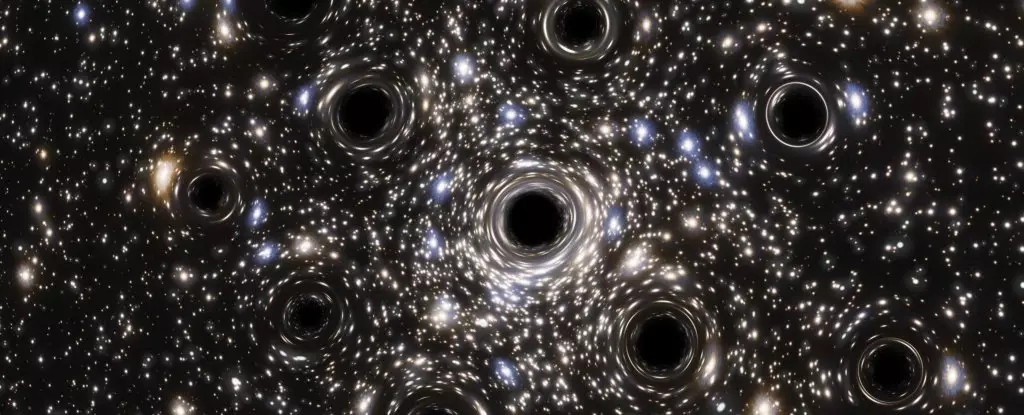In the vastness of the cosmos, globular clusters are akin to stellar time capsules, holding secrets of the universe’s early epochs. Among these, Palomar 5 stands out, both for its sheer beauty and the astonishing astronomical phenomena it harbors. Situated approximately 80,000 light-years from Earth, Palomar 5 extends over 30,000 light-years and showcases a large group of stars, presumably shaped by gravitational forces unique to its history. Though these star clusters are often likened to fossils from the early universe, Palomar 5 represents much more. Recent studies have suggested that this cluster could be home to over 100 significant stellar mass black holes, prompting a deeper investigation into its celestial architecture and behavior.
Globular clusters like Palomar 5 are dense spherical formations typically containing between 100,000 and a million ancient stars. They arise from a singular cloud of gas and dust, formed during the same cosmic epoch which birthed the universe itself. The Milky Way hosts more than 150 of these clusters, making them invaluable to astronomers seeking to unravel the history of our galaxy and understand the enigmatic presence of dark matter within it. However, in addition to these traditional structures, tidal streams are garnering more attention. These streams, long chains of stars that cling to galaxies, hint at dynamic past interactions, possibly involving once-solid clusters torn apart by gravitational encounters.
Until recently, identifying these tidal streams proved challenging. However, the advent of the Gaia space observatory has provided an unprecedented three-dimensional map of the Milky Way, illuminating several previously hidden stellar streams. This data fosters intriguing hypotheses regarding the nature of these streams. According to astrophysicist Mark Gieles, who has contributed significantly to this research, tidal streams could arise from disrupted star clusters. Yet, the absence of associated stellar systems in the majority of discovered streams leaves room for speculation. This background is crucial for interpreting Palomar 5’s role in cosmic evolution, fueling interest in understanding its internal dynamics and how its tidal stream was formed.
Understanding Black Holes in Stellar Clusters
Given these observations, researchers turned their focus towards the specific characteristics that distinguish Palomar 5. This cluster is exceptional, featuring not only its tidal stream but also an extraordinarily loose distribution of stars. Gieles and his team utilized sophisticated N-body simulations to recreate the orbits and paths of the stars within the cluster, attempting to grasp how they may have reached their current configurations. Central to their inquiry was the potential existence of a population of stellar mass black holes, which researchers believe can influence star trajectories dramatically through gravitational interactions.
The results of these simulations were startling. The researchers found that the number of black holes within Palomar 5 exceeded previous estimations by a considerable margin—about three times higher than expected based on the number of stars present in the cluster. This revelation implies that more than 20% of Palomar 5’s total mass may consist of black holes, each approximately 20 times the mass of our Sun. Their origin traces back to supernova explosions occurring when the cluster was still in its formative years, merging the tales of black hole genesis with stellar evolution.
Intriguingly, Palomar 5 is not destined to remain untouched by the relentless march of cosmic time. The researchers gleaned from their simulations that within a mere billion years, this cluster will completely dissolve, leaving behind a stream of black holes orbiting the galactic center. This impending fate underscores the ephemeral nature of globular clusters, offering insights into their lifespan and potential transformation into stellar streams. Consequently, it raises questions about the fate of similar clusters within the Milky Way and beyond.
Moreover, this investigation has implications for our understanding of black hole dynamics within stellar environments. It also lends credence to theories that posit globular clusters are fertile grounds for the formation of binary black hole mergers. As astrophysicists like Fabio Antonini note, the unknown variable in this scenario is the elusive nature of black holes themselves. With traditional observational techniques falling short, researchers are left to rely on simulated models and indirect evidence to estimate their population within these dense stellar groups.
The exploration of Palomar 5 serves as a vital cog in the intricate machinery of modern astrophysics, not just elucidating the behavior of globular clusters and their constituent stars, but also unveiling a treasure trove of black hole dynamics. As scientists continue to unravel the mysteries hidden in these celestial formations, they inch closer to answering pivotal questions about the nature of the universe itself, reaffirming that looking into these twinkling specks of light can reveal the universe’s grand narrative.


Leave a Reply